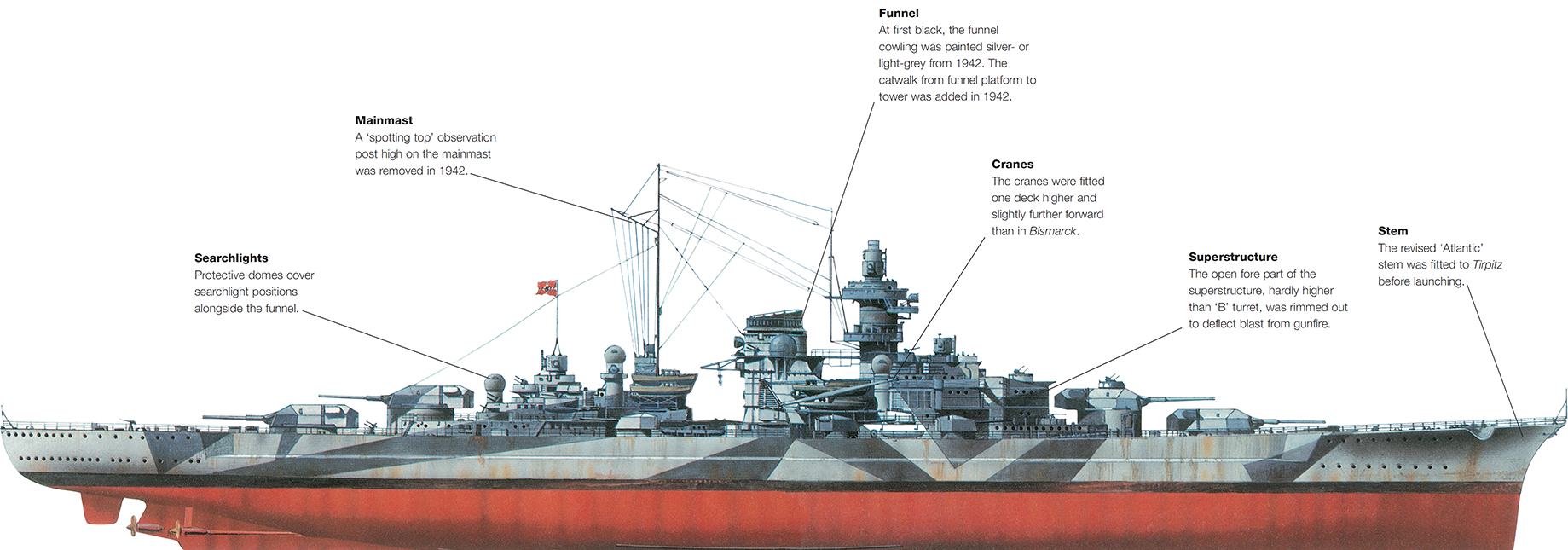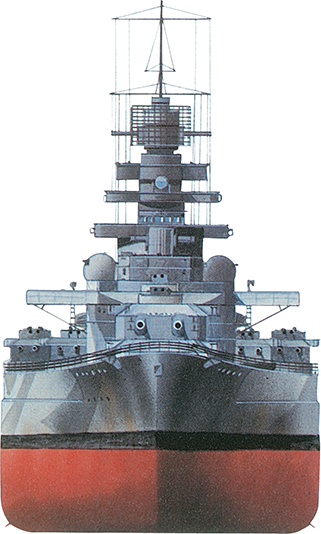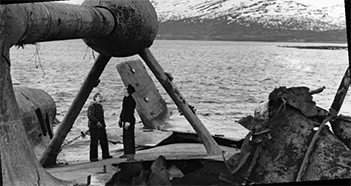 Tirpitz (1941)
Tirpitz (1941) Tirpitz (1941)
Tirpitz (1941)Sister ship to Bismarck, Tirpitz had similar qualities of power and resistance. Although its active service was very limited, the fact of its presence tied up substantial British resources until its ultimate destruction.
Tirpitz was laid down on 26 October 1936 at the Wilhelmshaven Naval Dockyard, launched on 1 April 1939 and completed on 25 February 1941. Its cost was 181.6 million Reichsmarks, 15.2 million less than Bismarck. It carried the same main armament, eight 380mm (15in) guns in four twin turrets, capable of firing three rounds per minute, 12 150mm (5.9in) guns in six twin turrets, 16 105mm (4.1in) and 16 37mm (1.4in) twin-mount AA guns. Tirpitz originally had 12 20mm (0.79in) single-barrel AA guns; this was reduced to 10, but supplemented by 40 20mm four-barrelled guns. From 1942 it also carried eight 533mm (21in) torpedo tubes in sets of four on the upper deck. Up to six floatplanes could be carried, and a double catapult was fitted.

Tirpitz is depicted below in ‘Paint Scheme K’ which it carried between March and July 1944. The camouflage style was frequently changed to confuse aerial observers.
The superstructures of both ships were very similar, with a foremast stepped on an upper level of the tower and a single large funnel. Numerous modifications were made in the course of 1941–44 to accommodate new radar and telecommunications equipment as well as extending the AA defences. Turbo-electric drive had been planned originally, since it had proved successful in fast ocean liners, but through doubts about its efficacy on a battleship the designers fell back on extra-high pressure boilers and steam turbines as in the Scharnhorst class.

Radar, at first able to indicate range but not height, was installed with a large aerial placed on the forward face of the rotating range-finder dome on the ship’s fore-top. Only Tirpitz and Bismarck carried a radar aerial fixed on the rotating dome above the command post. From 1941–42 a similar aerial was also placed on the after dome. In 1943–44, a ‘Würzburg’ radar set was installed on the after AA gunnery control position, with a 3m (9ft 9in) parabolic reflector for measuring height, and a Model 30 Hohentwiel radar aerial was mounted in the topmast.
Tirpitz would have been just as formidable as Bismarck, but its potential career as a fighting ship was distorted by its symbolic importance. After successful sea trials it joined the Baltic Fleet and remained with it until January 1942, when it was moved to northern Norway as a guard against invasion and in order to attack Russia-bound convoys.

The deck plan is essentially the same as that of Bismarck. Comparison with the cutaway profile below shows how much space was taken up by machinery, barbettes and magazines.
In March 1942 it fought off air attacks from the British carrier Victorious, shooting down two and was again unsuccessfully attacked from the air at Trondheim on 27–28 April. On 6–9 September 1942 its 380mm (15in) guns bombarded fortifications on Spitzbergen, but on the 22nd it sustained serious damage from attack by British midget submarines in Altafjord, near Narvik, and was out of action until March 1944. Russian as well as British aircraft made attacks, but the British were more successful, again causing serious damage on 3 April 1944 when 14 bomb hits were recorded.
As long as Tirpitz remained in northern Norway there was a serious threat to Russian and Atlantic convoys, and British efforts to immobilise it continued, hampered by the extent of AA defences not only aboard the battleship but in the surrounding area. They achieved some success on 15 September 1944 when 4572kg (10,079lb) bombs, used for the first time, left the battleship afloat but unseaworthy. Tirpitz was moved under its own power to Tromsö. By now the only future that could be prepared for was to use the ship as a floating battery.

This cutaway view of Tirpitz shows the position of the eight 38mm (15in) L/52 guns arranged in four twin gun turrets: two superfiring turrets forward – ‘Anton’ and ‘Bruno’ – and two aft – ‘Caesar’ and ‘Dora’.
The attacks continued. On 12 November 1944, in ‘Operation Catechism’, 32 Lancaster bombers of the RAF’s 9 and 617 Squadrons, from a base in Russia, converged on Tirpitz from 09:35. The ship’s main guns opened up on them from long range, but there was no aerial opposition from the Luftwaffe. The Lancasters scored at least two direct hits and four near misses with ‘Tallboy’ 5080kg (11,199lb) bombs carrying around 3000kg (6614lb) of high explosive. The most destructive hit was between the aircraft catapult and funnel, which blew a massive hole in the side armour.
Resilience
The fate of Tirpitz showed conclusively that the capital ship was no longer self-protectable; unless it could assume command of the air space around itself, it could only exist safely within a screen of anti-aircraft defences that itself negated the ship’s offensive value. The Luftwaffe was severely criticised for failing to provide adequate air cover, but by 1944 Allied air superiority was firmly established. As did Bismarck, Tirpitz showed remarkable staying power under sustained attack. The ‘Tallboy’ weapons that finally sank it had not been envisaged at the time of its design, and had been devised by the ‘dambuster’ scientist-inventor Sir Barnes Wallis specifically for the purpose of piercing its armour. Several hundred British and Russian aircraft made attacks over almost three years and many were shot down before the battleship was finally eliminated (see photo). Tirpitz did not have a ‘glorious’ career but its influence on the Arctic war was important.

When Tirpitz’s armour was designed, it was envisaged that the maximum destructive force would be around 500kg (1100lb) of explosive. No imaginable battleship could survive such an assault. The force of the strikes was enough to burst open the hull side and cause the ship to capsize, and at the same time one of the main magazines exploded. Around 1000 men were lost.
Specification
Dimensions |
Length 251m (823ft 6in), Beam 36m (118ft 1in), Draught 9.3m (30ft 6in), Displacement 38,283 tonnes (42,200 tons); 46,992 tonnes (51,800 tons) full load |
Propulsion |
12 Wagner superheated boilers, 3 Brown-Boveri geared turbines developing 102,906kW (138,000hp) |
Armament |
8 380mm (15in) guns, 12 150mm (5.9in) guns, 16 105mm (4.1in) guns, 16 37mm (1.5in) and 12 20mm (0.79in) AA guns |
Armour |
Belt 320–80mm (12.6–3.1in), Bulkheads 220–45mm (8.6–1.7in), Deck 120–80mm (4.3–1.7in), Barbettes 340–220mm (13.4–8.6in), Turrets 360–180mm (14.2-7in) |
Range |
16,430km (8870nm) at 19 knots |
Speed |
30 knots |
Complement |
2065 |